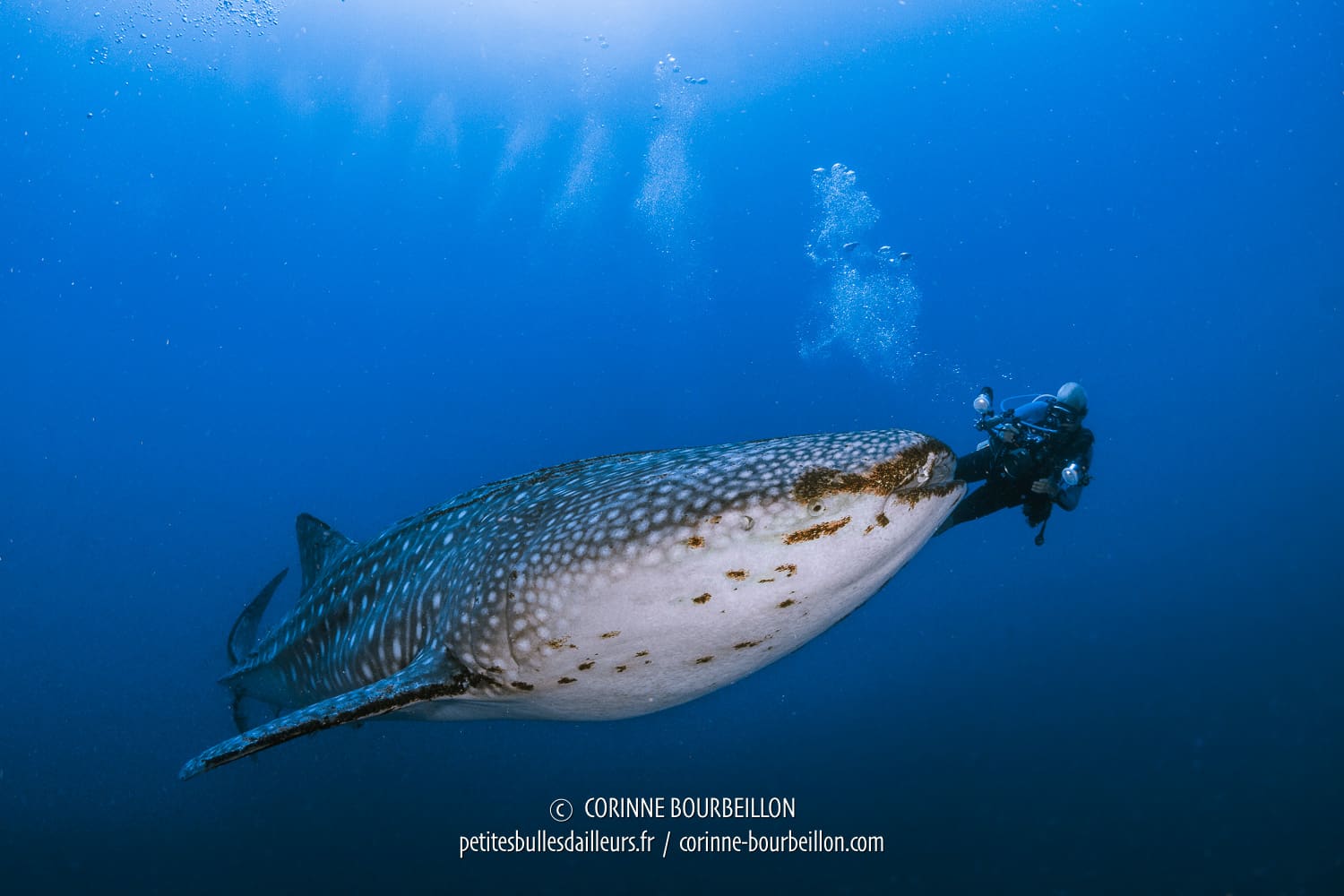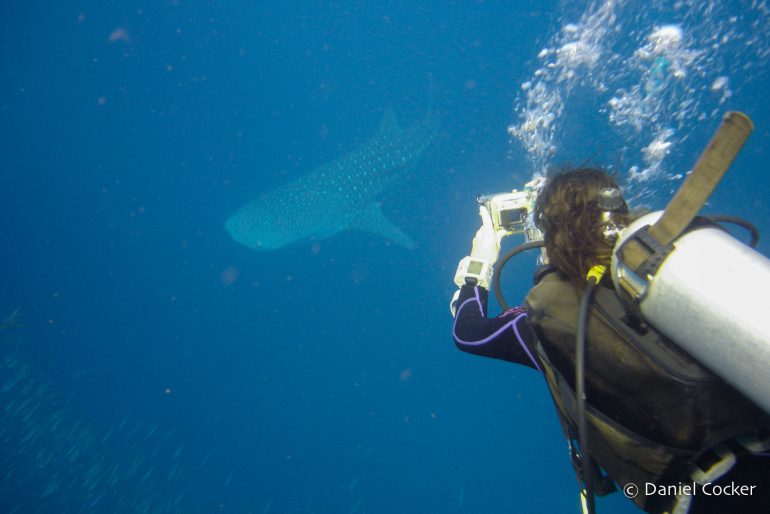Philippines : Tubbataha + Panglao - May 2018
Dear English-speaking readers, this page is an automatic translation of an article originally written in French. I apologise for any strange sentences and funny mistakes that may have resulted. If you read French, click on the French flag below to access the original, correct text:
In the Philippines, it is THE mythical encounter that all divers dream of: the whale shark, the largest fish in the world.
First whale shark in sixty years of diving!
I know someone who has been diving for almost sixty years and had never seen a whale shark before... 😄 This diver is the marine biologist Steven Weinberg !
Yes, the author of the famous books of identification of the underwater fauna and flora that are avidly read by biology enthusiasts. (For the uninitiated, we even say "the Weinberg" about his books which are a reference, a bit like we say "the Bescherelle" for spelling books).
I had the honor and good fortune to have had Steven Weinberg as a regular underwater buddy in the Philippines this May 2018. It was during a unforgettable liveaboard diving cruise at Tubbataha Marine Parkfollowed by a short stay in Panglao (Bohol Island). A trip organized by my friends Carol and Jérôme of the Equation diving center.
So I shared with Steven Weinberg a very big moment in his life as a diver and marine biologist: his very first encounter with a whale shark!!! 👌 Or more exactly his first two encounters with this splendid and harmless giant of the seas (this huge shark has no teeth, it feeds on plankton and small fish).
The first time was at Tubbataha. The second one in front of the reef Balicasag...an island across from Panglao. Moving pictures are worth 10,000 words... So here it is. a short video that I did underwater:
Photographing a whale shark in "macro" mode
Steven, who is seen paddling energetically close to the huge shark, had a "macro" lens on his camera (i.e. a magnifying lens made to capture the image of very small subjects). In short, it was impossible with this equipment to photograph a monster measuring 7-8 meters long!
And underwater, when you have an SLR camera locked in its waterproof housing, no way to change the lens. Yes, it's a shame... 😂 Leaving with a configuration for "small" and meeting "big" during the dive, it's the kind of anecdote that makes underwater photographers howl with laughter... The leader of the Photo-Sub Forum also made a little ironic comment on Facebook when he saw my pictures: "Who's that doing whale sharks in macro? 😱“
But while I was taking wide-angle shots, Steven, undeterred by his unsuitable configuration for the big beast, took advantage of his macro lens to photograph details: the whale shark's eye as well as the parasites it was covered with (these are the black marks we see around its mouth and on its fins).
They are very small crustaceans, which he managed to identify: "And who has photos of the shark's eye and skin, infested with thousands of copepod crustaceans (Pandarus rhincodonicus), right? And knock!" he replies to teasing people on Facebook.
I put some of his pictures below:

These "whale shark lice" can reach a centimeter in length and actually feed on algae and bacteria on its skin. It is therefore less a question of parasitism than of commensalismThis means that these small crustaceans take advantage of their host, but without harming it. They are a priori without danger for the whale shark, which has a very thick skin (about ten centimeters).
My quest for the whale shark
Unlike Steven, I for one had already encountered whale sharks before those two memorable dives of 2018 in the Philippines... But I wasn't always lucky in my quest for the world's biggest fish.
It should be known that the species is threatened with extinction and victim of the shark-finning(fins are worth a fortune in Asia, where they are considered a refined dish, even aphrodisiac). For divers, encounters with this beautiful animal are rare and always impressive ...
EPISODE #1: THAILAND 2006
"My very first whale shark was in 2006, in Thailand, during a diving cruise in the Similan Islands. It was a chance encounter, which happened on the landing. The animal, a rather young and curious specimen, had come to swim around us, for long minutes...
EPISODE #2: THAILAND 2007
One year later, still in Thailand, this time in Koh Lanta, I thought I was going to cross paths with a whale shark. Alas, I will only admire it in a video, made by another diver who had the good fortune to see him in real life…
EPISODE #3: PHILIPPINES 2008
The following year, during my very first trip to the Philippines, hoping to force fate a little, I went diving in Sogod Bay (island of Leyte)The bay is known to be frequented from March-April by majestic sharks. In vain. I didn't meet a single one during my dives. That's how it is, the ocean decides...
The dark side of the feeding in Oslob. In the Philippines, the presence of whale sharks is almost guaranteed at the well known spots ofOslob (Cebu Island) and Donsol (Luzon Island). But I have always preferred to avoid these sites where hordes of tourists come and where feeding of these wild animals (in Oslob) and snorkeling excursions (swimming on the surface with flippers, mask and snorkel) are organized without precaution, for commercial purposes. To understand better, I invite you to read the very informative post of the blog Little Travelers around the worldwhich explains the situation well.
The rather unshy whale shark that we were surprised to meet at Balicasag in this month of May 2018 (see the video at the beginning of the article) was surely coming from the site of Oslob in Cebu, the two islands not being very far from each other for this large migratory fish, capable of traveling long distances...
EPISODE #4: MEXICO 2014
The following years, I continued to dive a lot, mainly in Indonesia, but without ever crossing the path of a whale shark again... It was in 2014 that I was able to admire again several specimens, snorkeling this time, during the annual gathering of whale sharks off the Yucatán peninsulabetween the Gulf of Mexico and the Caribbean Sea.
From June to September, with a peak in July-AugustThey migrate by hundreds in these warm waters, where they can be observed feeding on the surface (of tuna eggs, among others). I had talked about it here, in the article below :
To read also, this scientific article in English → Why Giant Sharks Swim To Cancun For Spring Break: The Science Behind The World's Largest Whale Shark Aggregation
This spectacular aggregation of whale sharks takes place off Cancún, near Isla Mujeres and Isla Contoy. The event is natural, but has also become a tourist attraction. Since a few years, the approach of the boats and the launching of the boats have been fortunately regulated (only two people and one guide in the water at the same time per animal). It is therefore advisable to choose an authorized operator who respects surface procedures, in order to disturb the banquet of large fish as little as possible.
EPISODE #5: PHILIPPINES 2018
By going in this month of May 2018 on a liveaboard at the Tubbataha Reefs Nature ParkI knew that I had very strong chances, there, to meet a whale shark... 😉
Tubbataha is indeed a marine sanctuary, protected since 1988 and to the Unesco World Heritage in 1993. It is composed of two atolls and a high coral bottom, located far from any inhabited land, about ten hours sailing from Puerto Princesa (Palawan Island) in the open Sulu Sea.
The crossing is only possible and authorized to boats of diving tourists only three months of the yearIt is the most popular dive destination in the Philippines during the dry season (from mid-March to mid-June) when the area is not threatened by typhoons. It is THE mythical destination for diving in the Philippines. The park is home to many different species of sharks and fish, as well as manta rays, and the coral is splendid.
→ Photos and video: diving cruise in Tubbataha in May 2018
For us, it starts very strong: from the very first day, during our very first morning dive, my group has the chance to observe a whale shark!!! 😲 Small glimpse in the sequence below, where we see me struggling with my camera (the video mode refused to start). Thanks to Jérôme forEquation Dive Shop for the images:
As a result, while the whale shark is coming straight to meet me, I only manage to make two images (the pictures below), without adjustments, triggered in a hurry over the inoperative video mode...
Too bad. I enjoy the show. I admire the powerful sideways movement of its caudal fin, the gray livery with white spots very graphic. It is really a very beautiful animal, very impressive. Its quiet swimming fills me with a pleasant feeling of serenity...
I can't believe our luck. We finish the dive amazed, happy.

So at the beginning of the cruise, I am confident. There was one, there will be more! 👌
But as the days go by, I end up envying my little friends from the other groups. Several of them, more polished than us, are going to meet the huge fish again! This will not be our case. Well, in the absence of whale-shark, we will console ourselves with a manta ray...
And then, a few days after the liveaboard in Tubbataha, we experienced this second incredible encounter, totally unexpected, in the waters of Balicasag, whose video I put at the beginning of the article... A real surprise. Balicasag is a very nice diving site, but not known for the very big animals like Tubbataha. Here, in principle, it is mainly the kingdom of turtles!
But here it is... A whale shark was waiting for us near the reef !!!!

The two divers at the head of our group were the first to take advantage of it. Jerome from the Equation center, who is guiding us, knocks on his tank to alert Steven and me, who are as usual lagging far behind, busy with our cameras. He is very agitated and makes big signs...
At first, I don't understand. It is true that there is a magnificent school of jacks circling near the reef, but to get so excited... Then I see an imposing shadow taking shape in the blue. A silhouette that I know well. No way!!! 😲
I immediately begin to palmarize frantically, to see it more closely, quickly, before the big beast runs away!
But the whale shark of Balicasag does not run away. It lets us approach it, our noisy and sparkling bubbles do not seem to intimidate it. He quietly made great volleys near the reef and the school of jacks, not too deep, between 8 and 18 meters, leaving us all the time to admire him, for a good 20 minutes.
This giant must be about 7-8 meters long. He swims without hurrying, but we have to swim hard to follow his pace. Our air tanks are quickly emptied, we have to abandon it with regret, but we go back up with stars in our eyes...











